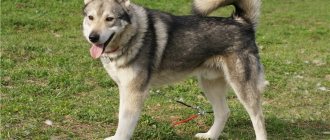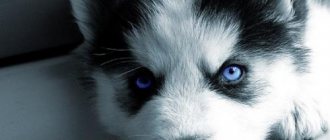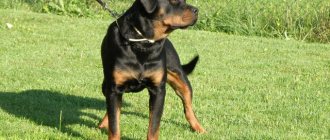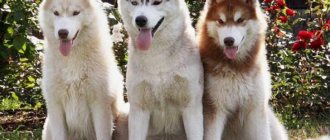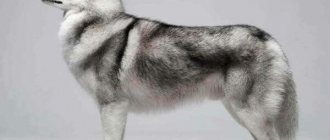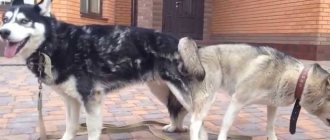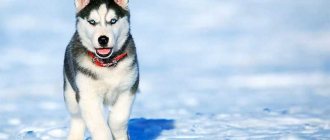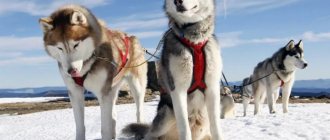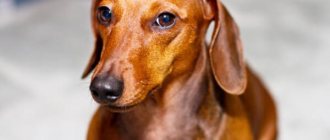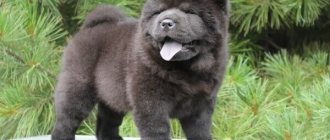Origin story
The breed was developed in the 1970s in the United States of America. American husky breeder Linda Sprulin had an unusually small husky puppy in her litter. The breeder decided to try to breed a small copy of her favorite breed, which would completely replicate the unusual and recognizable appearance of the husky.
History is silent whether only huskies were used to develop this breed by selecting small individuals for breeding, or whether the American resorted to the help of other breeds that were small in stature and resembled huskies (American Eskimo Spitz and Schipperke Shepherd).
Carefully and scrupulously carrying out selection, year after year, Alaskan Klee Kai puppies at the age of 8 months were tested for compliance with a certain exterior: the presence of a “reverse mask on the front of the head” and characteristic markings on the body, the severity of dark and light areas of the coat. No less attention was paid to the health of the dogs: when working on the breed, the breeders (Linda Sprulin and her friend who joined her) made sure that the miniature dogs were in no way inferior to ordinary huskies.
As a result, a new breed appeared, which is also called “mini-husky”. As a result of painstaking work, in 1995 the Alaskan Klee Kai breed received recognition from the American Rare Breeds Association, and after some time, the United Kennel Club (UKC).
Psychological picture
Small dogs are constantly and rightly accused of lack of intelligence, inability to train, poor health, increased gibberish, etc. The Alaskan Klee Kai cannot be accused of any of the above! Siberian Huskies, of which the Klee Kai are direct descendants, have always been famous for their intelligence. Unlike other dog breeds, they are capable of making independent decisions without waiting for approval from the owner. Dogs of this breed are incredibly smart and endlessly loyal.
Klee Kai practically does not bark. But they can imitate the sounds of a human voice when they want to be noticed.
The Alaskan Klee Kai is a very loyal and gentle family friend.
It warns its owners in advance about the approach of strangers and barks loudly.
Description of the Klee Kai breed
Unlike Siberian miniature huskies (resulting from a natural mutation without admixtures of other breeds), Alaskan Klee Kais are the result of the deliberate creation of a separate breed by crossing huskies and other dogs. Despite its similarity to the Husky, it is a separate breed. The main difference (besides height) by which we can guess that this is a Klee Kai is the tail. If the Husky proudly holds his tail in a “feather,” then the Klee Kai’s tail is cheerfully wrapped up like a donut. The presence of a maxi on the muzzle must be mandatory; in addition, it must be closed, which is not at all necessary for a husky.
The eyes of representatives of this rare breed are exactly like those of their ancestors: they can be either sky blue or deep brown. Particularly popular are puppies with eyes of different colors (for example, one may be blue, the other gray), as well as those in which one eye is colored simultaneously with two colors (this is called a “split”).
These dogs are beautifully built and look like a smaller version of a husky, and representatives of the toy class actually resemble toy huskies.
Key points in training
- Alaskan Klee Kais need to be introduced to obedience training from an early age. You can do this in group training. Dogs have a reputation for being independent thinkers and not always obedient.
- Mini-huskies are very active and agile animals, so they are perfect for agility classes and coursing.
- Representatives of the breed understand human body language very well, as well as facial expressions. Therefore, in order to correct the behavior of an Alaskan Klee Kai during training, you just need to change your facial expressions or make a movement with your hand. The animal will quickly and without words understand that the owner does not approve of its behavior.
Read about how to properly train a dog in the article: “Training a puppy: effective methods from dog handlers, learning commands at home.”
Sizes: from puppy to adult dog
The breed is distinguished by its miniature size: no more than 43 cm at the withers. Dogs are divided into classes, which depend on their height. Individuals up to 34 cm belong to the “toy” class, and their weight does not exceed 4.1 kg. Klee Kais, called "miniature", should weigh between 4.5 and 6.8 kg and stand between 33 and 38 cm in height. Mini Huskies between 38 and 43 cm and weigh between 7.3 and 10 kg are considered "standard". A height of more than 43 cm at the withers is considered a fault in Klee Kais and such individuals are discarded and not allowed for further breeding.
Read Dog Alabai: attitude towards children, reviews from owners
Table of dog sizes depending on age:
| 1-2 months | 3-5 months | 6-9 months and more | |
| Toy class | 10-13 cm. | 14-28 cm. | 29-34 cm. |
| Mini class | 10-13 cm. | 14-24 cm. | 25-38 cm. |
| Standard | 10-13 cm. | 14-32 cm. | 33-43 cm. |
Tips for choosing a puppy
The main rule is not to buy a dog secondhand, on the Internet, or through friends. This is the surest way to get a mestizo or an unknown breed. It is advisable to buy Klee Kai only in certified nurseries, from trusted dog breeders.
You should decide for what purpose the puppy is purchased: as a pet or for exhibitions. Only at the age of 8 months will it be possible to talk about the quality of a certain cub.
Then the correct mask is formed around the eyes, but if it is not symmetrical or not completely closed, then the puppy is considered to have a defect. Such individuals are immediately sterilized to prevent further breeding.
Before buying a puppy, it is recommended to carefully check its coat. A hard cover indicates improper maintenance. It is better to choose a well-fed Alaskan baby. It is also taken into account that you will have to wait in line for up to several months, the demand for puppies increases exponentially, and on average a female gives birth to 2-3 cubs.
It is also advisable to carefully study the documents of the little husky. The puppy must have mandatory vaccinations, pass all tests for common diseases and have a chip inserted.
Breed standard
The breed was recognized by the UKC (United Kennel Club, USA) on January 1, 1997, at the same time the Alaskan Klee Kai breed standard was approved.
In addition to the maxi on the muzzle and the curled tail, the breed is characterized by its color. Numerous variations of them are acceptable (dark or light gray with white, white, light to dark red with white markings, black and white), but only in combination with a pronounced facial mask. Insufficient contrast or blurred color is also unacceptable. In this case, the coat of a lighter color should be located on the throat, chest, hind and front legs and lower body. The color should look symmetrical. Albino Kai are allowed by the standard, but are subject to disqualification and excluded from breeding.
Representatives of the breed, naturally, due to their northern origin, have voluminous wool and a thick undercoat, and there are two types: standard smooth-haired and long-haired.
The following external characteristics are considered disqualifying characteristics according to the breed standard:
- various variants of malocclusion, such as undershot, overshot (straight, non-scissor bite is considered only a defect),
- eyes that are too wide or too close together, or protruding eyes;
- drooping or drooping ears (kai's ears should stand straight up and nothing else);
- the tail is too short, due to which it does not curl or does not touch the back when curled (unlike huskies, in which, on the contrary, a curled tail is a serious defect);
- too long coat, hiding the silhouette of the dog
- height above 44 cm;
- no black mask;
- uniform coat color without contrasting zones;
- completely white coat.
Since the breed is new, work on it continues to this day and it is quite possible that the requirements for it, including its external characteristics, will change over time.
Exterior
Alaskan Klee Kai or Mini Husky has the following conformation:
- Head and skull: miniature, wedge-shaped, without folds or jowls. The muzzle is elongated, there is a slight narrowing towards the nose. The nose is dense, the nostrils are wide.
- There is a pedigree mask on the face, like a Siberian brother. The forehead is wide, with a bright transition from the forehead.
- Ears: set high, triangles, hard cartilage, erect.
- Eyes: Medium size, round or almond shaped.
- Jaw, bite: medium size, white, strong teeth in full set. The bite type is scissors.
- Neck: medium long, well muscled, strong, without bending.
- Body, body: miniature, proportional, straight back without sagging. The loin is strong and well muscled. The abdomen is tucked up, there are no skin folds.
- Paws, tail: long, straight, stand parallel, elbows not turned out. The paws are collected in a dense ball, with strong black claws. Fingers are oval, not long.
Character and temperament
Klee-kai differ significantly from their relatives in character. If huskies are wayward dogs, independent of humans, then their miniature descendants have a softer character and are very attached to their owner. They are active, inquisitive and playful. The American Klee Kai has good intellectual abilities: it shows good results when learning various commands and is even capable of making independent decisions in difficult situations.
They are very clean and this quality is similar to cats. Miniature huskies have an unusual drawn-out bark, more like singing.
Klee Kais love to dig holes, and given their tendency to escape (inherited from a husky), owners should be on guard if the pet is walking on its own in the yard of a private house. Given this character trait of dogs, as well as the cost of one individual, some owners are afraid to let them off the leash, especially if the dog has not yet fully mastered the basic commands.
Read Is it possible to leave an Akita Inu with a child unattended?
When getting an Alaskan Klee Kai dog, it is worth keeping in mind that they are extremely active and require daily long games outside and physical activity. Despite its small size, this is not a couch dog and the genetics inherited from the husky make its presence felt.
Pros and cons of the breed
According to dog handlers, the advantages of Klee Kais include:
- original look;
- protective character trait;
- hypoallergenic wool;
- simplicity in content;
- quick, lively mind, ability to learn;
- accuracy.
A significant advantage of the breed is the absence of dog odor and the dog’s natural cleanliness. Klee Kais will always avoid puddles, never get into mud, and groom their coats frequently. A characteristic nuance is the washing process - like cats, they clean their faces with their front paws, dipping them in water. This peculiar feature makes the breed unique. There is a version that Klee Kais contain an admixture of blood from non-barking African dogs that have the same behavioral trait.
According to owners, Klee Kais are dogs with extreme intelligence. They understand human facial expressions, are loyal and sociable friends, have a balanced character and always try to please their household.
The disadvantages of the breed include negative concerns about the popularity of young breeding. It is believed that the Spitz dog variety has not yet manifested its genetic problems.
But today the main negative problem is the Klee Kai's pathological love of digging. This passion was passed on to them from the Husky during the breeding of the selective breed. The dog constantly digs holes everywhere. If you do not protect the house with a fence that goes deep into the ground, the pet can escape through a hole.
The natural curiosity and liveliness of small huskies also plays a negative role in the formation of the breed's shortcomings. For example, learning difficulties, where it is extremely important to start raising a puppy from an early age in order to later cope with the energetic and quick character of the dog.
Education and training
Considering the excellent intellectual abilities of Klee Kais, inherited from Spitz and Schipperkes, they can be trained quite successfully. You just have to make regular efforts and your pet will follow all kinds of commands. An active and independent clicker, if not properly raised and trained, can become uncontrollable and cause a lot of trouble for the owner.
Mini-huskies need regular physical activity, this could be frisbee (playing with a flying saucer), bikejoring (running next to a bicycle) or agility (traversing an obstacle course without the participation of a trainer). All of the above sports are very suitable for this breed because the combination of physical abilities, agility and mental abilities makes them easy for them to learn.
Photo and video review
After reading the description of the Alaskan Klickey breed, you can admire the photos and clearly see the uniqueness of such cute creatures.
Care and maintenance of the Alaskan Klee Kai
There is no need for special conditions for keeping and caring for a Klee Kai, unlike most small breeds. They do not need a haircut, or special clothing and shoes, because they are not afraid of the cold. Dogs are not susceptible to allergies and can eat absolutely any food, from carrots and raw potatoes to cereal porridge and meat. They shed twice a year, and the rest of the time they practically do not shed. They completely lack the dog smell: those who keep even a few Klee Kais at home say that they never smell the dog.
Great news for people who are allergic to dogs but want a four-legged friend: there are no allergies to mini-huskies.
They get along well with other pets, such as cats. You can summarize the advantages of keeping Klee Kais and see how economical these dogs are to keep:
- easy to care for (no need to spend money on grooming);
- even frosts of -40 are easily tolerated (no expenses for clothing);
- unpretentious in food, any high-quality food will do (no need to constantly sort through expensive hypoallergenic food and spend money on buying it);
- do not cause allergies;
- Small dimensions make it easy to keep in an apartment.
Therefore, for people who adore huskies, but live in cities in small apartments, Klee Kais are a wonderful opportunity to acquire a friend.
Advantages and disadvantages
Advantages of the breed:
- original appearance;
- presence of security capability;
- no allergies to wool;
- ease of maintenance;
- intelligence, quick learner;
- cleanliness.
The disadvantages include:
- price;
- small age of the breed (not fully studied);
- learning will require patience;
- there are many fakes on the market;
- It will take time to wait for a quality copy one by one.
Feeding
The unpretentiousness of the breed is expressed not only in its care, but also in its food. Mini huskies can be fed with both “natural products” and dry food of at least “premium” class. When choosing a natural feeding regimen, be sure to provide vitamin supplements. Since Klee Kais are absolutely non-allergic dogs, you can give them meat and vegetables, as well as various cereals and fish. Cottage cheese and low-fat kefir are given periodically. Like other dog breeds, puppies are fed 4-5 times a day depending on age, and an adult animal 2 times a day.
Exterior deviations of klee kai
Mini huskies may have the following deviations:
- Short or too long lower back;
- Long back;
- Short and narrow neck;
- Incomplete dentition;
- Overshot or undershot;
- Short shoulder, narrow hip;
- Atypical colors;
- Soft cartilage, ears do not stand up;
- Sagging back;
- Non-exit of testicles into the scrotum in male dogs;
- Various mental disorders, increased aggressiveness or, conversely, cowardice;
- Crooked paws, crooked tail.
Health and life expectancy
Mini-huskies are in good health and free from genetic diseases. At the initial stage of breeding, bleeding disorders were observed, which were completely eliminated thanks to thoughtful breeding practices. Several cases of congenital heart defects and liver shunts have also been reported. But these are isolated cases; in general, the breed is in good health.
Read What Alabai looks like: a complete description of the breed, interesting facts about the breed
Considering the very young age of the breed, it is possible that genetically determined health problems may emerge later, in the process of studying and further breeding Klee Kais. Klee Kais are considered long-lived among dogs: with proper maintenance and good care, their life expectancy is 14-17 years.
Diseases and treatment
Hereditary and genetic diseases have not yet been identified, since the breed has a small gene pool. But the breeding program is strict, and most likely, in the future, dogs will be free from the appearance of genetic diseases.
The lifespan of a mini husky is 15-17 years. Considering the small size of the dogs, they can be called long-lived.
How much does an Alaskan Klee Kai cost:
This is a fairly rare breed for our country. There are only a few nurseries in Russia that breed it. This largely determines the price of miniature huskies in Russia: the cost of a purebred puppy is approximately 350 thousand rubles. Buying a puppy in America costs much less, but the hassle of transporting it and completing the necessary documents will also take a lot of time and cost money.
The price of a puppy depends on what class it belongs to (show class, breed or pet), but the price range is not large:
- show class: 340-350 thousand rubles;
- breed class: 300-340 thousand rubles;
- pet class: 280-300 thousand rubles.
Also, the price of a dog directly depends on its size. For example, dogs of the toy class are very rare, and accordingly, they will cost much more than standard Klee Kais. Color also plays a role: a black-and-white puppy with blue eyes is valued more expensive than a gray-red-white puppy with brown eyes.
Follow the recommendations when buying a Klee Kai: inspecting the living conditions of the puppies and their parents, communicating with the breeder, checking the necessary documents, as well as assessing the character and reaction to the person. A mask on the face appears at about eight months of age, and only by this time experts are guaranteed to eliminate many defects, primarily those related to color. Only when a puppy is eight months old does its value as a representative of the breed and its price become clear.
Breeding
Currently, only professional nurseries are engaged in breeding Alaskan Klee Kais. The largest “number of heads” is found in the breed’s homeland – America. There are a small number of private breeders in Europe (England, Norway, France).
In Russia there are currently about five official places to purchase litters, and it took dog breeders several years to establish relationships with foreign suppliers of the breed. Only in 2013 did the first individuals appear on the Russian market.
American breeders do not sell Klee Kai puppies to private owners.
Rules of care
The coat, especially if the dog has long hair, needs to be brushed daily. During shedding, this procedure must be repeated several times a day, since otherwise it will not be possible to efficiently remove the abundantly falling out undercoat.
Klee Kais are bathed infrequently, only when necessary, and it is recommended to use special shampoos intended for dogs.
The dog's eyes, ears and teeth are cleaned as needed, although they should be examined every day. The ears are cleaned with cotton swabs, the eyes with cotton pads soaked in a special composition for cleansing them.
You usually take care of your pet’s teeth yourself, cleaning them while chewing on toys or treats purchased at a pet pharmacy. If plaque has formed, which cannot be removed in this way, then the dog’s teeth are cleaned with dog toothpaste and a toothbrush.
Claws, if necessary, should be trimmed with a nail clipper, but not with nail clippers and, especially, not with scissors.
Mini Huskies are very clean, in addition, they have the habit of washing themselves with their front paws, thanks to which they themselves keep their fur clean.
Man and dog
The Alaskan Klee Kai is a companion dog. It is not designed for hunting and intense sports walks.
Klee Kai is suitable :
- for a family with children: active and mobile, they become partners in games and walks, and can take on the functions of a security guard, as they are distrustful of strangers;
- for older people, such dogs are simply ideal: you will inevitably have to take them for walks regularly; click-kai will make up for the lack of communication;
- homebodies.
The breed is not suitable for very busy people who are rarely at home, as dogs love the attention of their owner, and if it is lacking, they can become uncontrollable.
Photos of color options
of colors are currently acceptable :
- Black and white.
- Grey-white.
- Red and white.
At the same time, black-and-white and gray-white dogs should have black pigmentation of the nose, as well as the edging of the eyelids and lips. For red and white mini huskies, the pigmentation of a dark brick or brownish-liver shade is desirable.
White markings are located in places strictly defined by the standard - on the head and muzzle, as well as on the neck, chest, limbs and stomach. In this case, it is desirable to have a narrow groove on the head, a closed mask and white eyebrows.
Not long ago, AKC was recognized as the standard for mini huskies and pure white color. However, individuals with this coat color are not yet allowed for breeding, even in their homeland.
Suitable for living in an apartment or outdoors?
Klee Kais are equally suitable for keeping in an apartment or in rural areas. They have quite thick and warm wool, and therefore they can easily tolerate not too severe frosts and live outside almost all year round.
In the apartment, the mini husky behaves quite decently: when left alone, it does not howl and does not spoil things.
When keeping a pet of this breed in an apartment, you will have to regularly go for walks.
Cost and purchase of an Alaskan puppy
Alaskan puppies are for sale in many cities. It is important to choose a pedigree pet, without defects or defects. Violations may include:
- Not a typical color, lack of a mask, not staining of the mucous membranes;
- Bite problems, tail kinks;
- Size too large;
- High growth.
It’s easy to buy a puppy now, the cost is from 25 to 60 thousand rubles.
The best puppies of the litter are sold at the highest price, depending on their future prospects and exterior characteristics. The breed is no longer considered rare, but quite expensive. The cost may increase if the litter is small: 2 – 3 puppies. Bitches will cost more.
It is not always possible to determine individual indicators, but it is worth focusing on the knowledge of the breeder and external data. Babies must be clean and tidy; check with the mother of the future pet in advance.
How to choose the right puppy?
You need to purchase Klee Kai only from a nursery. Moreover, since the breed is rare, you may have to wait quite a long time until the puppies that have not yet been reserved are born.
When choosing a baby, you need to pay attention not only to his appearance, but also to his character, temperament and state of health. The puppy must be active and playful, showing a friendly curiosity towards people and willingly communicating with other dogs in the kennel.
It is undesirable to adopt a puppy that shows aggression or cowardice - he will almost certainly have mental problems, which will subsequently greatly complicate his socialization and training.
NOTE!
Despite the fact that many nurseries provide such a service as delivery of the puppy to the buyer, it is better to go for the future pet yourself.
After all, it is not always possible to understand from a photograph how good a puppy’s exterior is. In addition, when buying a mini husky in this way, it will be impossible to check his psyche and temperament.
Differences between Klickies and Siberian Huskies
The Klikkai differs from ordinary Siberian Huskies in size.
Clickies are characterized by a tail set in a ring (like most huskies).
Photo 1. Externally, the Husky and the Alaskan Klickey are very similar.
The shades of fur and eye color, body proportions of the clicks were inherited from the husky.
The formation of the breed has not yet been completed, but at this stage the Click is an even more active and energetic dog, distinguished by its agility and curiosity.
Differences that are not fundamental for an amateur, but important from the point of view of the breed standard, include a pronounced mask on the dog’s face.
Huskies also have such a mask, but it is not expressed in such contrast. Due to this muzzle, clicking may seem more serious, but this is only an effect of its color.
The lifespan of Alaskan Klickeyes is 14-16 years.
Are they very similar to huskies and how?
Klee Kai is, as already mentioned, a mini-copy of a husky. Externally, these two breeds are very similar. The only difference is that the tail and size are different. The rest is the same. But their characters differ: if the husky is a proud northern sled dog, then the kai is a sweet home companion. Klee Kai is just a cat compared to a restless husky!
Mini husky next to husky
Alaskan Klicking's attitude towards children
Being very cute and friendly, these dogs become excellent friends for small children, and indeed for all family members.
As is the case with the same toy terrier and other small breeds of dogs, a strong child may not calculate his strength and then the dog will not be happy.
Photo 4. Attentive home friend
Klikai are very trusting and will not immediately “see through” any malicious intent towards them. But in general, they do an excellent job as a nanny, even despite their size.
In relation to strangers, these small representatives of the canine world are even capable of aggression.
They are quite wary, although reserved, about the appearance of new people in the house, but they can bite or bark for no reason only in case of real danger.
The Alaskan Klickey must be raised in conditions of love and constant attention.
In return, the owner of such a dog will receive a faithful and reliable friend, who does not leave him a single step, and is devoted to him with all his dog’s heart.
